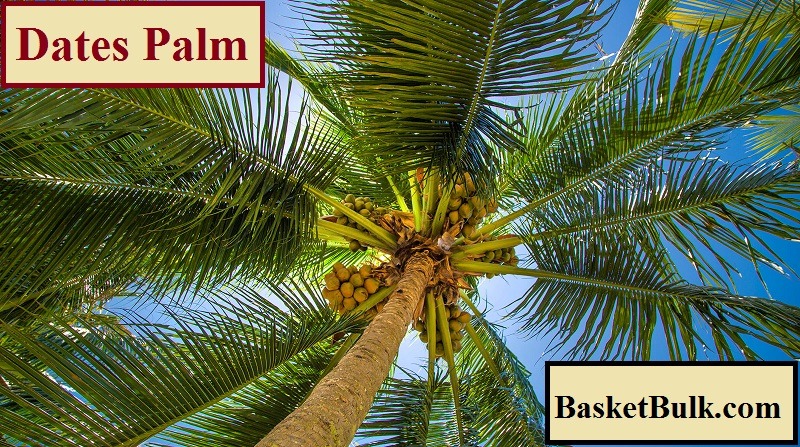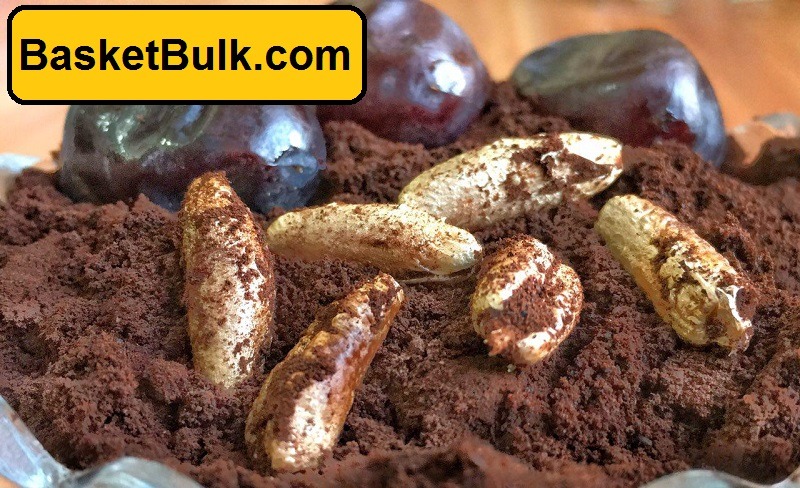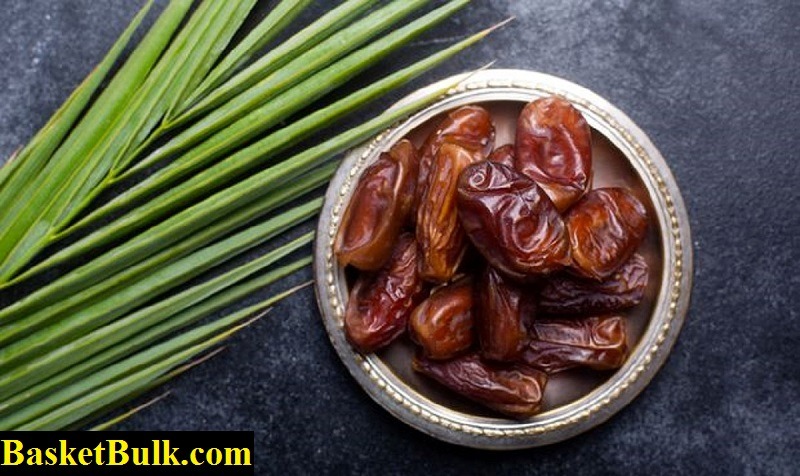Date Fruit: (dates scientific name: Phoenix dactylifera) is a tropical monocotyledonous plant with an edible fruit with a thin skin and a sweet taste and hardcore. The fruits hang in large clusters from the branch, and the leaves are large. The height of the palm reaches 10 to 20 meters or more.

What are date fruit?
Contents
Overview
| Species | Family | Genus |
| P. dactylifera | Arecaceae | Phoenix |
The date fruit species is widespread mainly in the northern hemisphere and Iran, Pakistan, Iraq, Saudi Arabia, and other Arab countries bordering the Persian Gulf and most of North Africa and the United States, and is also found in the southern hemisphere.
The unripe fruit of the date is first called “Pahak” (in Bushehr), and after turning yellow or red, it is called “Kharak” (and in Arabic, “Hababuk”).
Rutab is the pre-ripening stage of dates with more moisture and less sugar than fully ripe dates.
All parts of dates fruit are meaty and contain nutrients (date can eat even the seed). Date fruit has been in the human diet since ancient times and has been one of the humans’ oldest fruits.
History
The dates fruit family tree grows in tropical and subtropical regions, including Iran. Although its origins are mentioned in Mesopotamia, Saudi Arabia, and North Africa, scientific studies, it is known as P.H. Sivestris attributed to going to India. Archaeologists attribute the construction of the groves to 5,000 years ago because they got their name from clay tablets 50 centuries ago.
Palms and dates have been cultivated in Iran since ancient times and before the Achaemenid period. In Sassanid literature, including the book Bandheshan, the palm is mentioned.
Chinese sources refer to Iran as the land of date palms, known as Persian jujube and millennial jujube. At the end of the ninth century, date palms were taken from Iran to China and cultivated. Among European countries, Spain has a more extended history of date cultivation.
Nutrition and Benefits
Dates are naturally rich in vitamins B6, A and K. These vitamins help to grow bones and improve eye health. The fiber in dates improves gut health and naturally lowers cholesterol levels. Dates may reduce the risk of colon and stomach cancers.
Other minerals in dates such as calcium, iron, potassium, protein, manganese, magnesium, phosphorus, copper and sulfur improve the general functioning of the body. These minerals are useful for metabolism and immune system function. Folate in dates is useful for pregnant women, and thiamine is beneficial for the nervous system.
To see all the dates benefits and its minerals, read the supplementary article “benefits of dates“.
Side Effects
Although dates have many properties, people are usually not aware of the side effects of consuming too many dates. This tropical treat is a popular snack; But its high consumption can cause many problems for human health.
Consuming too many dates can lead to abdominal problems, skin rashes, weight gain, high potassium (hyperkalemia) and “fructose intolerance” disease.
To see all the dates benefits and its minerals, read the supplementary article “side effects of dates“.
Videos of Date Fruit
How to Eat Fresh Dates Fruit?
How palm date trees are grown?
Amazing benefits of dates
Different Types
Types of dates are divided into two categories: fresh dates and dried (and semi-dried) dates. Each contains a different taste, size, and property.
Fresh date fruit or Wet date fruit:
Fresh dates fruit has higher moisture. Generally, these dates have a higher sweetness. Among the types of these dates, we can mention [kimia date – bam mazafati date – rutab barhi date – shahani date, etc. ] Due to the characteristics of this type, refrigeration is needed for transportation and storage and may not be found in all seasons. (This type is also known as soft dates)
Dried date fruit:
Moisture is more melancholy in this category. The sweetness of this date is lower than fresh dates. Among the types of these dates, we can mention [ Piarom date – Kabkab date – Rabbi date – Zahidi date – Sayer date – Lulu date, etc. ] Due to the characteristics of this type, refrigeration is not required for transportation and storage. (This type is also known as hard dates)
Dates can also include semi-fresh dates or semi-dried dates in the above category, and it is not necessary to consider two different types for it. [dried fruit dates] [dried fruit dates]
In this article, we tried to introduce you to the types of dates available in Iran, of course, there are other types of dates that are less known in other countries. To view this type of date and buy from sellers, follow the link. Wholesale Dates.
Taste
Dates are considered sweet fruits. But if we want to look more closely, some types are less sweet. Therefore, they are divided into two categories: very sweet and sweet.
Among its sweet varieties, we can mention Zahidi dates, and from very sweet, we can mention Mazafati dates.

Cultivation
Cultivation of dates or the creation of palm groves is flourishing in the world’s tropical regions.
Pajush
“Pajush” are the buds that grow on the stem or root of the plant.
In the past, farmers planted date kernels, which was not economically and temporally cost-effective. In a way that the degree of male and female growth was not known from the date kernel and people needed a limited number of male trees, a large number of male trees could grow unused and cause their pains, but the use of “Pajush” It solves this problem. Remember that for the “stump” to separate from the mother tree, and it must be three years old.
It is possible to catch “Pajush” in every season, but the heat of summer and cold of winter reduce this percentage, so early spring and autumn are better times to do so.
Cultivation of date tissue
In this case, a part of the young plant tissue of the palm tree is equipped in laboratory conditions and cultivated using stimulants. These seedlings need care for three years in a semi-enclosed and cared environment, and they produce about five years after planting.
This planting method has the following advantages:
- It is possible to mass-produce it.
- It is very suitable for export.
- It has a higher advantage than “Pajush” because it is not infected with the virus.
- It is possible to plant it in all seasons.
Fertile palm
In this case, the mature palm is uprooted and planted elsewhere.
Products made from date fruit
Dates can be consumed as fruit or processed and transformed into various forms. Tree wood, palm leaves, etc. can also be used, which we will mention below.
Date Seed: There is a hard kernel inside the date fruit. This core cannot be consumed without processing. By making changes, it becomes a powder and is used instead of coffee.
| Read more: Date Seeds Benefits |
Date Syrup: Just as dates have benefits, their syrup also has many benefits. Due to its abundance and naturalness, it is used in industries instead of sweeteners.
| Read more: Date syrup Benefits |
Chopped Date: Dates are cut into pieces and consumed with tea or coffee instead of sugar.
- They make baskets from the leaves and branches of the palm tree.
- They make bread from date seed: Date seed are turned into powder and then this powder is mixed with water and the dough obtained from it is turned into bread.
- They also drink date seed powder instead of coffee: Date coffee drink tastes very similar to coffee. Many people are reluctant to drink coffee because of caffeine. This drink is a good alternative for these people.
- Dates are used for food and as a fruit: Dates are found in dry, fresh and semi-dry varieties. This fruit is sweet and delicious and has many properties. This fruit can be eaten with almonds, pistachios and other nuts.
- Dates are used as a sweetener in the confectionery industry.
- Dates can be used with tea instead of sugar.
- The people of the desert soak it in water for a few days and give it to their camels as nutritious food.
Pests of date fruit
To prevent date pests, it is necessary to pay attention to date preservation from the beginning of planting the product. Store dates after harvest is also important.
One of the most important pests of dates is Oractes elegans, Batrachedra amydraula.
You will see as soon:
- Dates in different cultures and religions …..
- Date production statistics in each country …..
- video and image gallery about cultivate etc ….
Book Introduction
| Date Palm Genetic Resources and Utilization: Volume 1 | jameel M. Al-Khayri, Shri Mohan Jain, Dennis V. Johnson · 2015 This important 2-volume reference book is the first comprehensive resource reflecting the current global status and prospects of date palm cultivation by country. This volume covers Africa and the Americas. |
| Date Palm Genetic Resources and Utilization: Volume 2 | Jameel M. Al-Khayri, Shri Mohan Jain, Dennis V. Johnson · 2015
In reality, the old practice should be updated by the international better practice to use plastic sheets beneath the date palm tree during harvest process to collect the harvested fruit bunches and keep fallen individual fruit free of … |
| Sustainable Pest Management in Date Palm: Current Status and Emerging Challenges | Waqas Wakil, Jose Romeno Faleiro, Thomas A. Miller · 2015 The seasonal biology of E. ceratoniae is closely linked with the developmental stages of the date fruit (Nay and Perring 2008a). Carob moth does not feed on nonfruiting structures of dates, but they will infest the fruit of other hosts, … |
| Pests and Diseases of the Date Palm | J. B. Carpenter, H. S. Elmer · 1978
These conditions should be taken into account in planting and maintaining date orchards . wherever dates are grown . The economic importance of fruit rots varies greatly , since their incidence is governed by the occurrence of rain and … |
| Date Palm Biotechnology | Shri Mohan Jain, Jameel M. Al-Khayri, Dennis V. Johnson · 2011 For instance, exogenous application of antioxidant substances such as alpha-tocopherol, enhanced the ability of date palm seedlings to tolerate environmental stress and improved growth performance (Awad et al. 2005). |
Q&A about date fruit
How to store dates in the freezer?
Fresh and dried dates can be stored in the freezer for up to a year to keep them fresh. To freeze, place the dates in the freezer bag and vent. Leave some space for freezing dates. Then place in the coldest part of the freezer. When consuming, remove the dates 3 hours before. Melt the ice slowly or place in a bowl of warm water.
In general, due to the abundance of dates anytime and anywhere, it is better to eat dates fresh.
Is it necessary to wash or peel the dates before eating?
From a health point of view, it is necessary to wash dates like any other fruit before eating. There are all kinds of microorganisms and contaminants in groves.
Due to the dust phenomenon that has caused many problems in recent years in the western and southwestern regions of the country, washing dates before consumption has become more necessary, so it is recommended to wash dates thoroughly before consumption, but do not need to separate It does not peel it.
Why do some dates become sour?
Dates are rich in carbohydrates (sugars) and if the conditions for the growth of microorganisms are provided, soft dates, which have more moisture than their dried counterparts, will ferment quickly and get a sour taste and smell.
Relatively warm and humid air and the presence of oxygen are essential for the growth of microorganisms and the fermentation process, and if dates are stored at low temperatures such as refrigerators and in closed containers, their storage capacity will increase.
…
source:
BasketBulk.com
wikipedia.org
https://www.frontiersin.org/articles/10.3389/fpls.2017.00845/full
